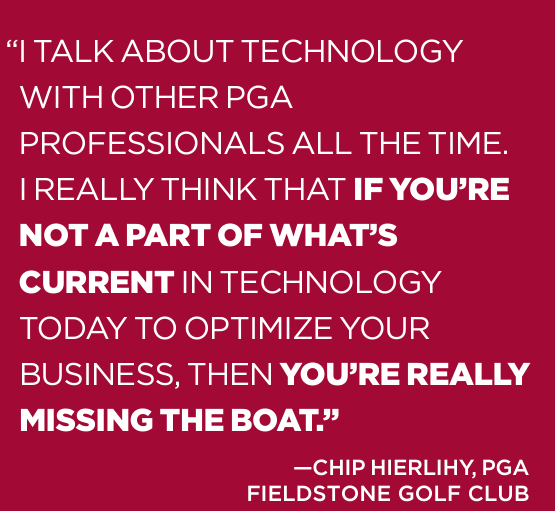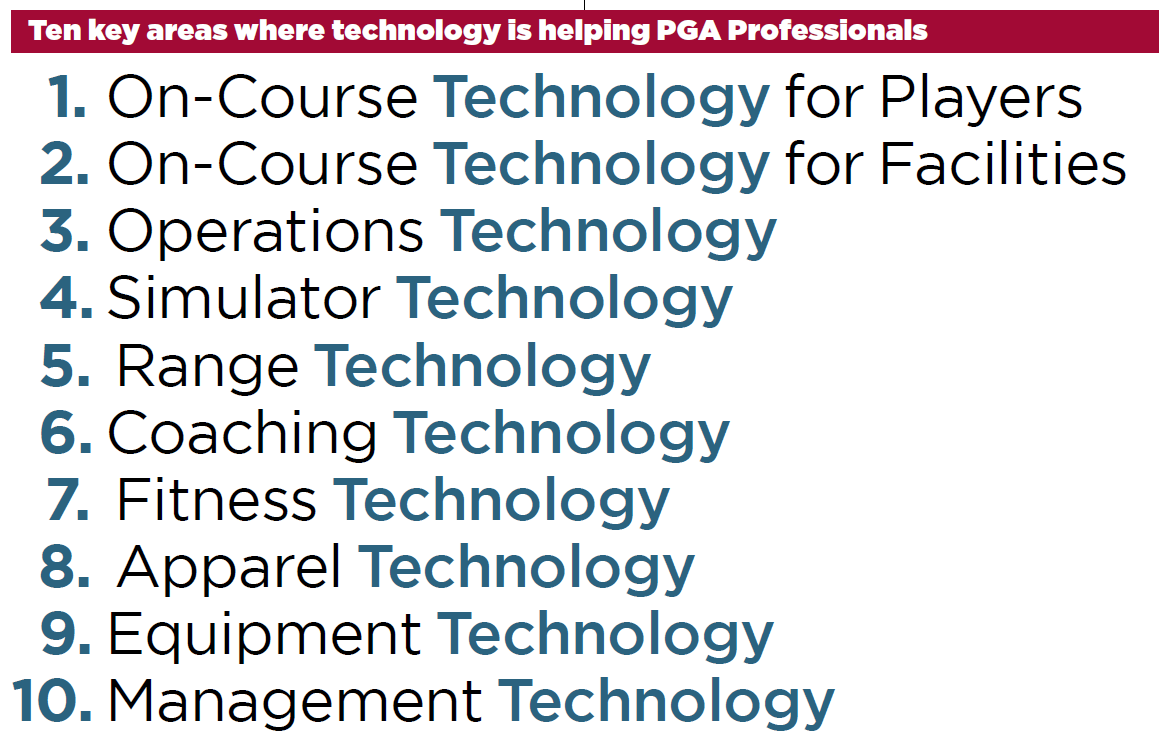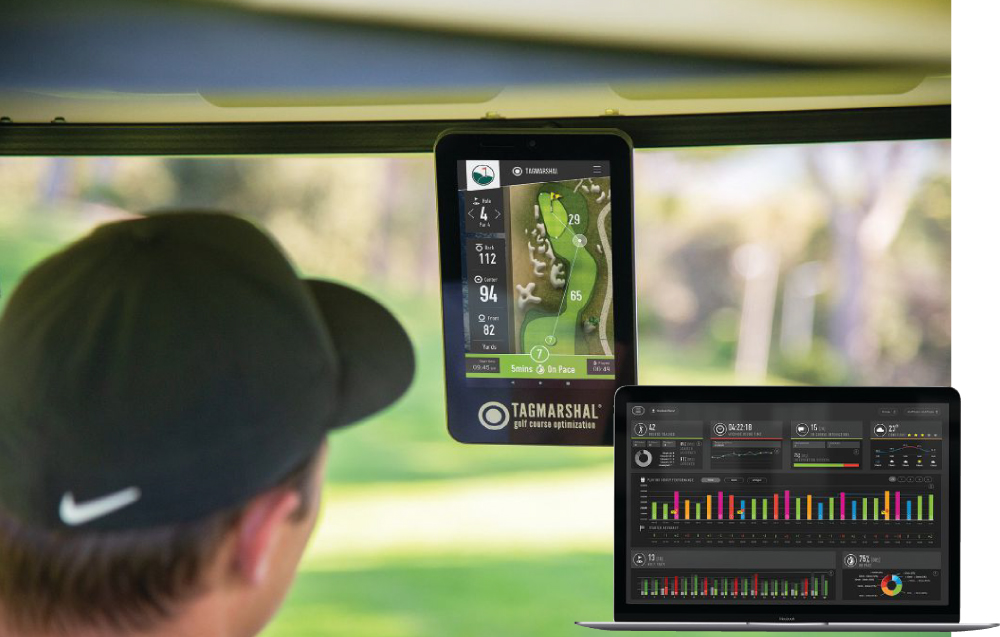NEWS
How technology impacts PGA Professionals
By Don Jozwiak, Senior Editor, PGA Magazine
Fairly or not, golf is seen as an extremely traditional game – and also as a business that is slow to change its time-honored ways. A closer look at the current state of the sport and the way PGA Professionals operate their facilities, however, shows that golf has embraced technology in myriad ways that would have seemed unlikely or even impossible less than a decade ago.
From the consumer standpoint, technology is sweeping through the game. On the course, game tracking devices and smartphone apps help players track their strengths and weaknesses, while golf cars equipped with internet service make it possible to order food, listen to music or even watch a football game without interrupting a round.
Improvements in equipment performance and clubfitting advances have also made it easier to dial in performance, with the help of PGA Professionals, and high-tech fabrics have made golf apparel and footwear more comfortable and protective from the elements. And on the coaching side, PGA Professionals are able to help players improve more efficiently with the data from launch monitors and other performance-tracking tech.
Technology also continues to change the business of golf in ways that may not be obvious to consumers, but are making a massive difference to owners, operators and PGA Professionals. GPS tracking is making it possible to streamline oncourse traffic, helping facilities improve pace of play while accommodating more golfers. Maintenance vehicles also are equipped with GPS for more efficient use, and some courses are deploying robotic mowers that can mow at night. Software solutions are creating efficiencies in tee times, dining reservations and inventory, while helping PGA Professionals benchmark performance and collect customer data.
Technology is also intertwining with golf beyond the course. Simulator technology has made the game a weatherproof, year-round activity like never before for consumers around the country, adding new revenue streams in food & beverage and social gatherings.
Ranges have become a technology hub, with shot-tracking solutions creating gamified practice options unlike anything the game has seen – look no further than the Toptracer and Toptracer Range, the official range technology of the PGA of America, in high-profile use at the Home of the PGA at PGA Frisco. And as golf fitness expands, motion trackers and advanced fitness equipment are helping golfers feel better and stay more active, which benefits both players and the game itself.
 Something particularly interesting about most of these technologies is how quickly they’ve become mainstream. Technologies that were once experimental or aspirational are now proven performers, making them less risky as investments. Simulators are an excellent example of a technology that was once an expensive bet on a market that was not well established. Now simulators can be found in traditional high-end private clubs, resorts, daily fee courses and off-course facilities, and the proven return on investment and many established best practices for incorporating a simulator into an existing business makes the technology a much easier sell to owners and operators.
Something particularly interesting about most of these technologies is how quickly they’ve become mainstream. Technologies that were once experimental or aspirational are now proven performers, making them less risky as investments. Simulators are an excellent example of a technology that was once an expensive bet on a market that was not well established. Now simulators can be found in traditional high-end private clubs, resorts, daily fee courses and off-course facilities, and the proven return on investment and many established best practices for incorporating a simulator into an existing business makes the technology a much easier sell to owners and operators.
In fact, there may actually be more risk involved in shying away from technology than in embracing it. Investing in technology improvements at your facility can bring benefits in a number of areas, such as:
- Reducing costs by increasing efficiency;
- Getting to know your customers better through tracking their spending and engagement;
- Showing tech-savvy younger members and potential customers that your facility is in step with them;
- Attracting talented new employees who expect to use the latest technologies in their careers; and
- Establishing that your facility is forward looking.
In addition to those areas, bringing proven technologies to your g olf facility can help PGA Professionals work more efficiently, leaving more time to spend interacting with golfers throughout the day.
olf facility can help PGA Professionals work more efficiently, leaving more time to spend interacting with golfers throughout the day.
“We’re using a lot of different technology solutions throughout the club, and they’re all meant to enhance the experience for members and guests – and to get our PGA Professionals out from behind the desk,” says Craig Thomas, the PGA Head Professional at Metropolis Country Club in White Plains, New York.
“The members don’t want me sitting in my office running invoices or in the back room doing inventory. They want me out on the range or the first tee, shaking hands and introducing guests to their PGA Professional. And that’s a lot easier for me now than it was even five years ago.”
On-course Technology for Facilities
While improving the experience for golfers is obviously of paramount importance, so is technology that allows facilities to enhance and streamline the on-course experience in ways that directly impact revenue and utilization – while helping make the operation run more efficiently as the labor market remains tight.
For example, technologies that help run tournaments, outings and leagues – like Golf Genius, Unknown Golf, Gallus and Cap Patrol – save valuable time for PGA Professionals. Solutions like Golf Genius, which automates processes like generating scorecards, inputting scores and calculating winnings, allow PGA Professionals more time to spend with golfers instead of dotting scorecards or poring over results at the end of an event. And Cap Patrol works in tandem with tournament solutions, helping PGA Professionals get a handle on handicaps to avoid sandbagging and keep events fair for all participants without spending valuable time searching for golfer handicaps online.
Even golf car fleets have become technologically advanced, with new lithium-ion battery golf cars requiring less maintenance and leaving less wear on the course due to lighter designs, while internet-connected golf cars allow PGA Professionals to keep the vehicles out of sensitive areas on the course, in addition to providing connectivity for ordering food & beverage or communicating with the golf shop during a round.
Golf cars are also part of the pace of player solutions that technology is making possible at many golf facilities. With the surge in golf that started at the onset of the coronavirus pandemic, pace of play became an even greater issue at some facilities due to increased rounds played and the sheer number of newer – and slower – golfers on the course. Companies like Tagmarshal, Izon, AccuPin and FAIRWAYiQ have become integral elements in helping facilities maintain or even improve the flow of play, which leads to benefits across the board.
At New York’s Metropolis Country Club, Thomas and his staff deployed Tagmarshal’s GPS-based player tracking technology to overhaul the private club’s pace of play strategy.
“At a private club like ours, we don’t have rangers because the members just don’t respond to them. When play slowed down in the past, we’d inevitably get a call in the golf shop from an upset member, and the problem would already be affecting multiple groups,” Thomas says.
“Now we just clip a Tagmarshal tracker onto one bag in each group that goes out and we can follow the flow of play throughout the course from a screen in the go lf shop. When we see a gap in play, we can quickly send a member of the golf staff to ride out and address the situation before it becomes a logjam that slows down the entire course.”
lf shop. When we see a gap in play, we can quickly send a member of the golf staff to ride out and address the situation before it becomes a logjam that slows down the entire course.”
In the first season Metropolis used Tagmarshal technology, the club decreased round times by 12 minutes on average even as the number of rounds played increased by 34 percent. The club has since grown out more native grass and increased the speed of its greens, but the pace of play improvements have remained despite the course playing more difficult for its 250 members.
“The members really enjoy the faster pace of play that’s happening even though the course is playing significantly hard than it used to,” Thomas says. “We’ve maintained 10-minute tee time intervals, and for members it just all happens in the background. It’s been very helpful for managing traffic on course and making sure we can get out all the members who want to play without any pace of play issues.”
Management Technology
A final piece of the technology puzzle – and one that helps unlock better business performance for many facilities – is in benchmarking, where data is analyzed to improve earning potential. Companies like Sagacity Golf and Club Benchmarking are at the forefront of this trending technology, and the PGA of America has partnered with Sagacity Golf to create PGA Operations Benchmark as a free benefit to PGA Professionals who want to better understand conditions in their local markets.
One facility that has seen strong results from using Sagacity Golf’s services is Fieldstone Golf Club, a municipal course owned by the city of Auburn Hills, Michigan, just north of Detroit. PGA General Manager Chip Hierlihy was looking for ways to optimize the facility’s performance during the current golf boom and was interested in trying dynamic pricing – a system like what airlines use to lower or raise prices based on demand.
Sagacity works with Fieldstone to flex the facility’s published rate – $71 during high season – plus or minus 40 percent based on demand for a given time or day. No effort is required from the golf staff, other than being educated on how dynamic pricing works so they can explain it to customers. Between implementing dynamic pricing and bringing in Tagmarshal to improve pace of play – cutting nearly an hour off the average round time a t the busy facility – Fieldstone is able to get more golfers on the course at pricing that better serves the bottom line.
t the busy facility – Fieldstone is able to get more golfers on the course at pricing that better serves the bottom line.
“We have a 30-day booking window, and if you’re booking a tee time for a Tuesday a few weeks out, golfers might get something around $50 or less – but if they’re calling on Friday to play on Saturday when we already have 250 people on the tee sheet, they might be paying $93,” Hierlihy says. “No one else in our market was doing dynamic pricing. In 2021, when we made the switch, revenue went up 25 percent over 2020, which we thought was our high water mark. Then in 2022, we went up another 10 percent, and we’re still going higher so far in 2023.”
Other facilities have noticed Fieldstone’s success in the highly competitive Detroit market. Three of Fieldstone’s biggest competitors have since brought Sagacity Golf on to implement their own dynamic pricing systems. “I take it as a positive that other facilities are seeing what we’re doing and jumping on board,” Hierlihy says. “I talk about technology with other PGA Professionals all the time. I really think that if you’re not a part of what’s current in technology today to optimize your business, then you’re really missing the boat. ”
Source: PGA Magazine, July 2023
ABOUT TAGMARSHAL
Tagmarshal, the market leader in on-course optimization technology, provides courses with full, real-time operational oversight and reporting, giving golf operators the tools to manage pace and flow of play effectively, resulting in enhanced player experiences, increased efficiency through automation, and additional revenue generation.
Tagmarshal’s technology has collected over 1 billion data points from more than 50 million rounds of golf and has relationships with in excess of 500 partners, including Hazeltine, Whistling Straits, Baltusrol, Fieldstone, Bandon Dunes, Serenoa and Erin Hills.
Tagmarshal partners with several golf management groups, private, daily fee, public and resort courses, including 35 of the Top 100 US courses, as well as many $30-$50 green fee courses, which are seeing excellent results using the system.


 WATCH DEMO
WATCH DEMO